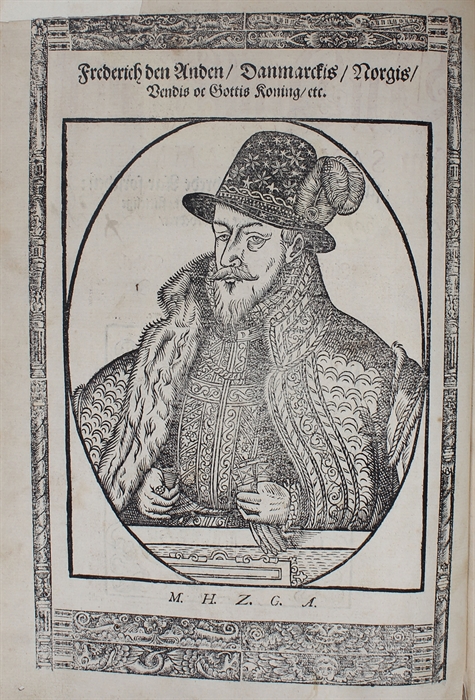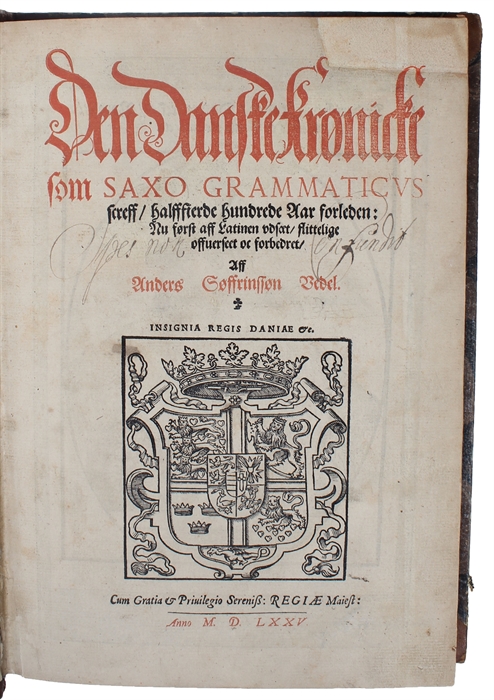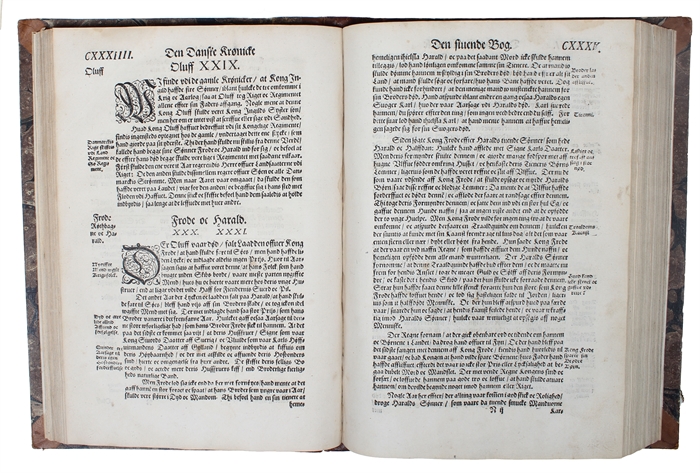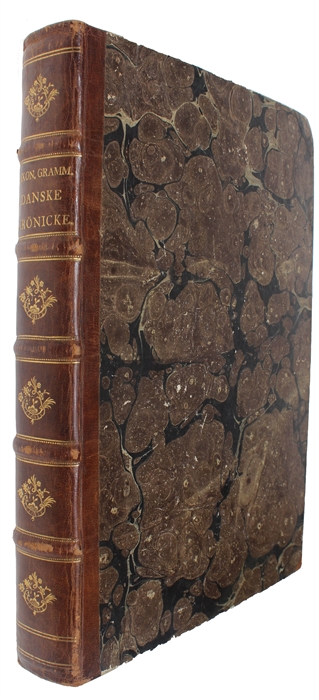FIRST DANISH TRANSLATION OF THE NARRATIVE OF HAMLET, PRINCE OF DENMARK
SAXO GRAMMATICUS.
Den Danske Krønicke som Saxo Grammaticus screff, hallfierde hundrede Aar forleden: Nu først aff Latinen udsæt, flittelige offuerseet oc forbedret, Aff Anders Søffrinssøn Vedel.
Kiøbenhaffn, Hans Støckelman oc Andreas Gutterwitz, 1575.
Folio. Bound in a very nice mid 19th century brown half calf with five raised bands and gilt ornamentations to spine. Title-page printed in red and black and with large woodcut, verso with full-page woodcut portrait of King Frederik II. Small repaired cut-out to top of title-page and an old owner's annotation. Neat marginal annotations to some leaves and early annotations to back fly-leaf. Occasional light brownspotting, but overall an unusually well kept and fresh copy, printed on good paper. (36), 547, (33) pp.
The very rare first translation into any language, being the seminal first Danish translation, of the first preserved full history of Denmark - to this day the most important of all Danish historical publications and a main work of European Medieval literature. This magnificent work furthermore contains the first known written narrative of the legend of Hamlet and served as the basis for Shakespeare's play. ""Hamlet" is based on a Norse legend composed by Saxo Grammaticus in Latin around 1200 AD. The sixteen books that comprise Saxo Grammaticus' "Gesta Danorum", or "History of the Danes", tell of the rise and fall of the great rulers of Denmark, and the tale of Amleth, Saxo's Hamlet, is recounted in books three and four. In Saxo's version, King Rorik of the Danes places his trust in two brothers, Orvendil and Fengi. The brothers are appointed to rule over Jutland, and Orvendil weds the king's beautiful daughter, Geruth. They have a son, Amleth. But Fengi, lusting after Orvendil's new bride and longing to become the sole ruler of Jutland, kills his brother, marries Geruth, and declares himself king over the land. Amleth is desperately afraid, and feigns madness to keep from getting murdered. He plans revenge against his uncle and becomes the new and rightful king of Jutland." ("Shakespeare's Sources for "Hamlet" " - Shakespeare-on-line). The patriotic "Danish Chronicle" (i.e. Gesta Danorum) by Saxo Grammaticus is without comparison the most ambitious literary production of medieval Denmark and the most important source for the early history of the nation, also being one of the oldest known written documents about the history of Estonia and Latvia. Its sixteen books describe the history of Denmark and the Danes as well as Scandinavian history in general, from prehistory until Saxo's own time (12th century). It offers crucial reflections on European affairs of the High Middle Ages, from a unique Scandinavian perspective, and constitutes a significant supplement to other Western and Southern European sources. Saxo Grammaticus (ab. 1150-1220) was probably a secular clerk or secretary to Absalon, Archbishop of Lund, the great Danish churchman, statesman and warrior. Saxo is remembered today as the author of the first full history of Denmark, in which he modelled himself upon the classical authors (e.g. Virgil, Plato, Cicero) in order to glorify his fatherland. The work dates from the end of the 12th century and was first printed, in Latin, in Paris in 1514 with 16th century re-issues following in 1534 (Basel) and 1576 (Frankfurt). In 1575, the very first translation of the work appeared, that into Danish, which came to play a significant role in the history of both the legends presented in the work and in Danish language and culture. This groundbreaking first printed translation of Saxo's chronicle was prepared by the Danish historian and philologist Anders Sørensen Vedel (1542-1616). Vedel was also the tutor of Tycho Brahe and his companion on Brahe's grand tour of Europe, where the two formed a lasting bond of friendship. Previous attempts had been made at translating Saxo's magnificent work (one by Christiern Pedersen, one by Jon Tursen), but none of them were printed and the manuscripts have also not survived; Vedel's translation is the only one that was finished and made it to print. Prompted by Absalon, Vedel began his translation in 1570, and it took him five years to finish the task of both translating and rewriting the original Latin text. While working on this grandiose production, he was given the income of a canon at Ribe Cathedral. Vedel's translation is one of tone of the most important Renaissance contributions to Danish literature and to the development of the Danish language. Vedel's work is not merely a translation, but a magnificent rewriting that should be considered a literary masterpiece in its own right. After Vedel's translation, Saxo remained the indispensable classic that overshadowed all other historical works, both as a source to the earliest history of Denmark and the Danes and as a source of the Nordic myths. Vedel's seminal translation predates the first English translation by more than 300 years and remained the only vernacular version of the text for centuries. The work consists of sixteen books that cover the time from the founders of the Danish people (Dan I of Denmark) till Saxo's own time, ending around 1185 (with the submission of Pomerania), when the last part is supposedly written. The work thus covers the entire history of Denmark until Saxo's own time, seen under a somewhat glorified perspective, from heathen times with tales of Odin and the gods of Valhalla to the times of Absalon, who probably directly influenced the sections on the history of his own time, working closely with Saxo himself. The work also contains the first known written narrative of the legend of Hamlet (Amleth, the son who took revenge for his murdered father). It is this narrative of Saxo's, which he based on an oral tale, that forms the basis for Shakespeare's "Hamlet", which takes place in Helsinore in Denmark. There is fairly certain evidence that Shakespeare knew Saxo's work on the History of Denmark and thus the legend of Amleth. "This is the old, Norse folk-tale of Amleth, a literary ancestor of Shakespeare's "Hamlet". The Scandinavian legend was recorded in Latin around 1200 by the Danish historian Saxo Grammaticus and first printed in Paris in this beautiful 1514 edition. It is part of the collection of tales known as Gesta Danorum - a partly mythical history of the Danes. Saxo's Amleth story - a summary a villain who kills his brother, takes over the throne and then marries his brother's wife There are equivalents for Shakespeare's central characters - old and young Hamlet, old and young Fortinbras, Claudius and Gertrude, Polonius, Ophelia, Rosencrantz and Guildenstern. But Saxo has no ghost demanding vengeance, and the identity of the murderous uncle is known from the start. There is no Osric, no gravediggers or play within a play. The legend lacks a Laertes character and the young woman does not go mad or kill herself. Perhaps most crucially, Amleth lacks Hamlet's melancholy disposition and long self-reflexive soliloquies, and he survives after becoming king." ("Saxo's legend of Amleth in the Gesta Danorum" - The British Library.mht). "Saxo Grammaticus, (flourished 12th century-early 13th century), historian whose Gesta Danorum ("Story of the Danes") is the first important work on the history of Denmark and the first Danish contribution to world literature. Laur.Nielsen 240. - Thesaurus 190.
King Rørik of Denmark appoints two brothers, Horwendil and Fengo, as the rulers of Jutland. Horwendil slays the King of Norway, marries King Rørik's daughter Gerutha, and they have a son named Amleth. Consumed by envy of his brother, Fengo murders Horwendil and marries his wife Gerutha. Amleth then feigns madness, clothing himself in rags and spouting nonsense, to shield himself from his uncle's violence. In fact, the name 'Amleth' itself means 'stupid'.
Yet Amleth's behaviour attracts suspicion, and the King attempts to trap him into admitting he has plans for revenge. First, a beautiful woman is used to lure him into betraying himself, but she proves loyal to Amleth. Then a spy is planted to eavesdrop on Amleth's conversation with his mother, in which she repents and he confesses his plans for revenge. Amleth detects the spy, kills him in a mad frenzy, throws his mutilated body in a sewer, and leaves it to be eaten by pigs. Fengo then deports Amleth to England with two escorts carrying a letter directing the King there to execute him. Amleth switches the letter with another one, which orders the death of the escorts and asks for the hand of the English Princess in marriage.
Returning to Denmark, Amleth arrives disguised, in the midst of his own funeral, burns down the hall and hunts down his sleeping uncle. Because Amleth had wounded himself on his sword, attendants had made it harmless by nailing it to the scabbard (the sheath used to hold it). Amleth swaps this useless sword with Fengo's, succeeds in killing his uncle and next day is hailed as the King.
...
Saxo's account has many of the defining features of Shakespeare's drama:
a cunning young hero, the King's son, who pretends to be mad to shield himself from his uncle
three plots used by the King to uncover the young man's secrets: a young woman, a spy planted in the Queen's bedroom (who is uncovered and killed), and two escorts who take the prince to England (also outwitted and killed)
a hero who returns home during a funeral and finally achieves his revenge through an exchange of swords.
Little is known of Saxo's life except that he was a Zealander belonging to a family of warriors and was probably a clerk in the service of Absalon, archbishop of Lund from 1178 to 1201. Saxo is first mentioned in Svend Aggesen's Historia Regum Danicae compendiosa (1185; "Short History of the Danish Kings") as writing the history of Svend Estridsen (d. 1076).
The Gesta Danorum was written at the suggestion of Archbishop Absalon: its 16 volumes begin with the legendary King Dan and end with the conquest of Pomerania by Canute IV in 1185. The work is written in a brilliant, ornate Latin. It was his Latin eloquence that early in the 14th century caused Saxo to be called "Grammaticus." The first nine books of the Gesta Danorum give an account of about 60 legendary Danish kings. For this part Saxo depended on ancient lays, romantic sagas, and the accounts of Icelanders. His legend of Amleth is thought to be the source of William Shakespeare's Hamlet; his Toke, the archer, the prototype of William Tell. Saxo incorporated also myths of national gods whom tradition claimed as Danish kings, as well as myths of foreign heroes. Three heroic poems are especially noteworthy, translated by Saxo into Latin hexameters. These oldest-known Danish poems are Bjarkemaalet, a battle hymn designed to arouse warlike feelings; Ingjaldskvadet, a poem stressing the corruptive danger of luxury upon the old Viking spirit; and Hagbard and Signe, a tragedy of love and family feuds. The last seven books contain Saxo's account of the historical period, but he achieves independent authority only when writing of events close to his own time. His work is noteworthy for its sense of patriotic purpose based on a belief in the unifying influence of the monarchy. By presenting a 2,000-year-long panorama of Danish history, he aimed to show his country's antiquity and traditions. Saxo's work became a source of inspiration to many of the 19th-century Danish Romantic poets." (Encycl. Britt.)
Order-nr.: 53247




